|
Part
2 - CHILE TO EASTER ISLAND
23.2.07
Crossing the Pacific Ocean:
island of mystery
Early start for 8.50 a.m. flight to Easter Island. The hotel is less luxurious
than the previous ones, we didn’t expect anything else out here. We
hadn’t expected the smell though, reminiscent of an old Blackpool
B&B plus the foistiness that comes with constant damp. It’s hot
and humid, more so because apparently they have been having a lot of
rain here lately. We have umbrellas but no waterproofs. No fear we are
abandoning our Englishness then.
Walk into the main town, a few minutes along the shore. Sticky even
though the sky is very overcast and there is a little breeze. Dogs
everywhere. One adopts us, follows us, even waits for us while we have
tea and cake. Boys are surfing in the bay at Hanga
Roa, big waves. The town is simply a crossroads, very few useful shops
but lots of cafes and diving shops. The long shed marked
‘supermarket’ has a single row of tables, mostly empty. Many people
riding horses bare back through town, obviously their usual mode of
transport. Hens everywhere too.
We see our first Moai which overlooks the harbour at Hanga Roa, or
rather has his back to it. There is a nice feel to the place and I love
being near the sea at last. Two cities are my absolute limit. We have
dinner at the hotel, no butler in sight! Short walk along the shore and
we see young folk, all wearing brightly coloured tropical shirts, in
beribboned pick-up trucks, apparently heading for some wedding or
pre-wedding bash over the hill. The backs of the pick-ups are full of
folk too.
24.2.07
Before we left I came across a bit of Japanese poetry which now I’m
here seems to sum up being in these vast reaches of the Pacific.
Spring
approaches
the
Pacific Ocean
will be my
sitting mat
Soen Rschi
We are far away from anywhere, and it feels like it.
Booked
a tour for this afternoon, gives us time to post cards and get passports
stamped [at the post office, $1 a pop] – as it is Saturday, things
start to close at noon.
We find out another deficiency of the hotel, the plumbing. Takes a lot
to flush the toilet and nowhere near adequately, however long you keep
your hand on the handle.
Harvey
comes out of the bathroom, marching purposefully to the French windows
to the garden. I need a stick
he says solemnly. For a moment I am mystified, then I remember a similar
occasion at Maureen and Tug’s house. He comes back with a bit of a
stick with which he proves very resourceful over the course of our stay,
but it’s too close to a declenching tool for comfort. [ref for the
uninitiated - Couples TV prog]
Dawn comes late here, around 8a.m. with cocks crowing and dogs barking.
Though it had been overcast yesterday, I wake this morning sunburnt
where my T-shirt ended, a huge red ring round my neck as if I’ve been
the victim of an unsuccessful strangling in the night. Not a pretty
sight. Thank goodness for aloe vera which not only takes the sting out
of it, but starts to tone down the redness.
At first glance the island looks a lot like
Galloway
, and then you get your eye in and see the volcanic shape to the hills,
and volcanic rocks strewn everywhere.
To our surprise, we are not only booked on the afternoon tour, but this
mornings and tomorrow’s full day as well! Luckily we are about ready
to walk to the village when the tour called to pick us up. I feel
pleased with our spontaneity; we just went! Not very English at all.
Elena our tour guide speaks excellent English and is interesting as well
as informative. Our first stop is Orongo,
a small village of 55 ancient houses reminiscent of the houses at Scara
Brae in Orkney but in use more like the summer shielings of Scotland. For one month during the year, men would come down here to take part
in the birdman competition. Would-be leaders sent young fit men to
compete on their behalf, scaling down 200ft cliffs, followed by a long
swim in turbulent seas to an island in order to collect the first
seabird egg of the year. This decided the leaders of the clans for the
next year – he was the Birdman; the symbol is the top half of a bird,
bottom half of a man, holding aloft the egg. The custom continued until
the arrival of the missionaries in 1860; they declared it pagan and
stopped it, along with much else besides, one supposes.
Next stop, Rano Kau, a
volcano. We climb up to the rim, 1km in diameter, the biggest volcano on
the island though not the oldest. Jacques Cousteau plumbed its depths in
the 1970’s, found it to be 200m at the centre. Reed grows on the water
now, and the hillsides are covered with fruit so hard to harvest that
the birds have it all.
Last stop to see a cave looking very like an Orkney geo. The ceiling once had paintings of the birdman symbols, but the sea washing in over
centuries has eroded them to a small patch, difficult to make out.
We get the coach to drop us at the Hanga Roa post office where we post
cards and have our passports stamped with a Moai impression, just as
they are closing. Lunch in a small café from where we can see the Moai
and the sea. We order scallops and fresh bread, both delicious though we
are rather surprised that the scallops are very thinly sliced and raw.
After
Harvey’s recent episode, we are a little wary, thinking not only of the
travel ahead but the dreaded plumbing back at the hotel. Fears prove
groundless on all counts.
The afternoon tour takes us inland on terrible mud roads [due to the
unseasonal rains] to Puna Pau,
the quarry where the red stone topknots [representing hair] of the Moai
were carved. Still many lying around, part finished as if the workers
were suddenly interrupted.
Then on to Ahu Akivi [ahu is
a platform on which the Moai stand], our first line of Moai [pronounced
mow-eye]. These are not the biggest but they are impressive. The ahu was
the burial place of the clan leaders and the Moai are effigies of them,
raised on the ahu. During the ceremony, eyes would be put into the empty
eye sockets of the statues, made from white coral and black obsidian. At
the end of the ceremony they were removed, so that only one original eye
has ever been found.
The countryside round here is lovely, with very many horses roaming
freely. They are all branded and belong to people, but are allowed
freedom to roam.
Onwards to see a lava tube leading from the volcano to the sea 3km away.
The caves so formed were used as vaults for family members not important
enough to be buried on the ahu. Each family had its own cave. Later
people hid in them from marauding Peruvians who took men and boys to
work down the mines in
Peru
. There is such a maze of cave-tunnels that they couldn’t be found.
Another stop at Ahu Vinapu,
two ahu, one built with huge interlocking stones similar to those seen
at Machu Pichu. This platform was specially strengthened to hold the
largest Moai ever made, which lies unfinished at the quarry we’ll see
later. It is 22m high and weighs 160 tons, the topknot would add another
50 tons. What happened to stop this?
There are only 2 known female Moai, one of them here. It is 9th
century and now eroded
almost beyond recognition.
A great day spoiled only by getting soaked to the skin on the way home
from dinner [also a disappointment], in spite of our very British
umbrellas. Not what we needed when things don’t dry because of the
humidity and we have to check out of the hotel tomorrow morning even
though we don’t fly until late evening.
25.2.07
Rain hammered on the roof all
night, but the tour goes ahead, this time a full day with lunch
included.
First stop is Vaihu, a
platform by the sea with many toppled Moai. The Moai were toppled after
the clan wars, so that any we see standing have been restored in the
last 40 years. There was also a tsunami, after an earthquake in
Chile
, which moved some of the fallen topknots well inland. All the Moai
except one group face inland, maybe to watch over the villages, but no
one really knows why. The island is full of mystery.
Our second stop, Ahu Tongariki,
is also a platform by the sea. This is the one featured on all the
postcards, the one we most want to see. 15 Moai on a huge platform, all
different shapes, sizes and features. Only one still has a topknot. This
group took 10 years to restore. It’s a beautiful setting so close to
the water, very atmospheric. During the tour we meet Richard who is just
retiring from the Navy, having been based in
Portsmouth
. Richard is throwing himself into his trip with a joy it’s great to
see, having himself photographed at every possible opportunity for the
record. He kindly returns the favour, one of the few photographs of us
together.
Our guide took us next to the Moai quarry at Rano Raraku, an amazing hillside with 400 unfinished Moai of varying
sizes, including one huge one still attached to the rock face. Some are
standing, some at an angle, many laid flat on the earth. The path
meanders in and out of the Moai over quite a distance. A bit eerie, like
some alien graveyard.
Lunch is served here for us, brought out in hot containers from the
hotel; chicken and rice with salad. There are little market stalls too,
where we buy souvenirs.
The countryside round here is dotted with broken down platforms, often
quite small, and Moai that were in transit when it all stopped. The
island certainly has a ‘Marie Celeste’ feel. We see the biggest Moai
ever moved from Rano Raraku, weighing 74 tons, plus its topknot from
Puna Pau Quarry we saw yesterday, 12 km away. How it got so far is a
mystery, and why it stopped where it did is a mystery too. This huge
Moai was the last one to be toppled. The Dutch Admiral Jacob Roggeveen
anchored off the island in 1722, naming it in honour of his arrival on
Easter Sunday. Roggeveen noted that it was standing then, while on a
visit a few years later, he recorded it toppled.
Moai date from the 3rd century when the Short Ear clan
arrived, bringing carving skills. The Long Ear clan was already settled
here, calling the island ‘the naval of the world’. They used the
Short Ears to carve memorials – the Moai - to their leaders. All
carving stopped after the clan wars.
I ask Elena if it is easy for Easter Islanders to trace their ancestry.
She said they all know who they are descended from; she is a Long Ear.
35 families are still unmixed with other races, but only 3 Long Ear
families are left. In the old days, the Long Ears elongated their ear
lobes by inserting stones to weigh them down. The ancientness of these races feels different to our own.
Last stop of the day is at Anakena,
a beautiful beach with ahu and Moai. Absolutely gorgeous beach, palm
trees, golden sands, horses roaming. Four of the Moai here still have
their topknots, that’s unusual. It’s so lovely that I sit for a
while on my own on the sand, imagining a house on the hill looking down
on this beach and sea. Idyllic.
Back to the hotel for a shower, change of clothes and repacking the
suitcases. We surrendered our room when we left after breakfast, so have
to use the public facilities which are less than adequate, the kind of
shower which is so small the plastic shower curtain sticks to you. Yuck!
Nowhere private to dry and change. But at least we feel civilised again.
Very English! How did I ever manage to fear we might lose it?
Luckily I had managed to convey to one of the staff, a Japanese woman
who spoke a little English, that my soaked pants from the night before
needed somewhere to dry rather than being packed in a plastic bag in my
suitcase. They are indeed dry and though rather creased are better for
travelling in, being my only pair of long pants. We’re all ready in
the small lounge, waiting for our lift to the airport, when one of the
staff tells us the plane is delayed ‘for operational reasons’ for 4
hours. This pushes our departure time back to after midnight, and there
is nowhere to get a cup of coffee or any drink other than water. The TV
is playing loudly in Spanish, but there is nowhere else to wait. Too wet
outdoors to risk getting another soaking just before we travel, so I lay
full length on a sofa I’ve bagged, and sleep for a while.
Even Richard’s good spirits seem dampened by this delay.
|
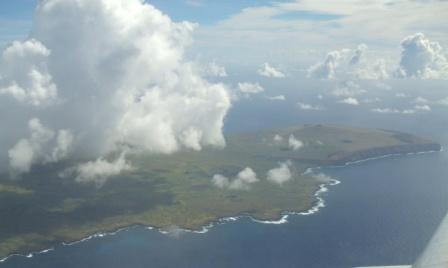
Easter Island
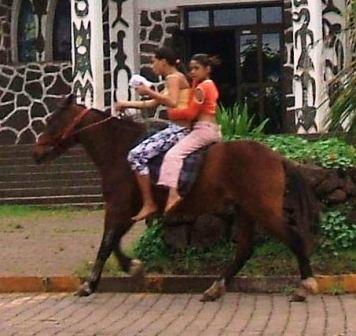
Hanga Roa transport
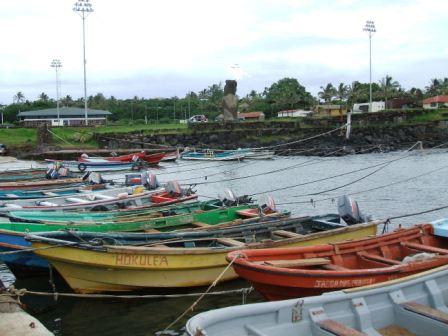
Hanga Roa
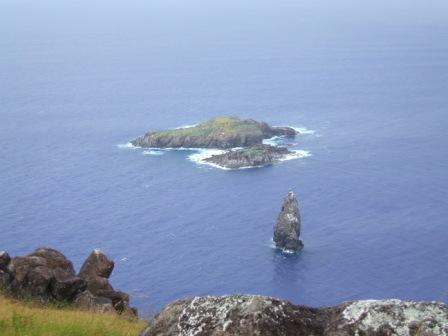
Birdman Island
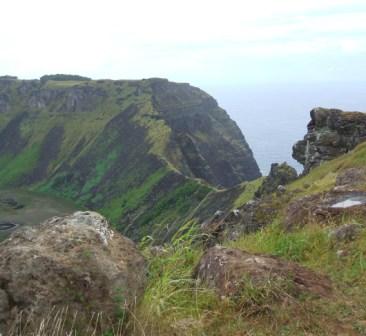
Lip of the Volcano, Rano Kau

S&H at Ahu Akivi
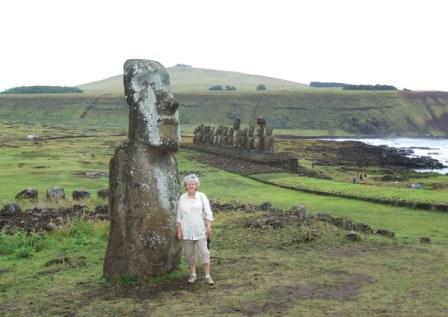
Ahu Tongariki

Two Moai at Ahu Tongariki,
the one below still has his topknot
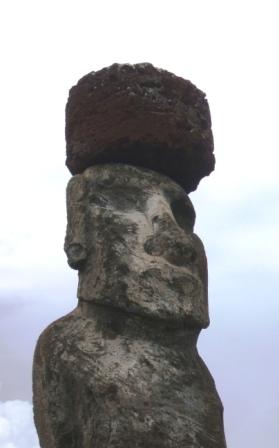
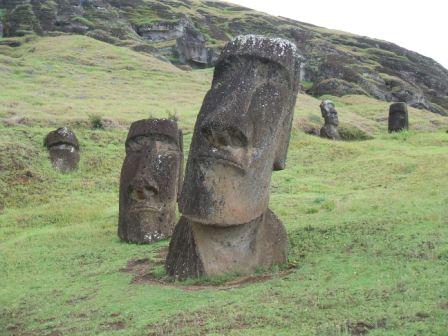
Some of the 400 unfinished Moai at Rano Raraku,
the Moai quarry
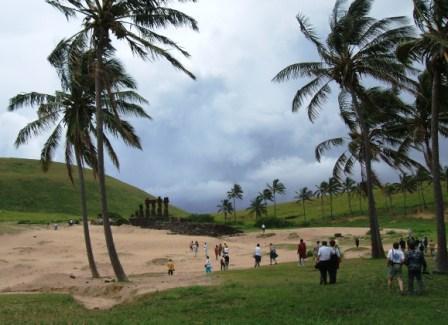
Moai in the distance at Anakena
|